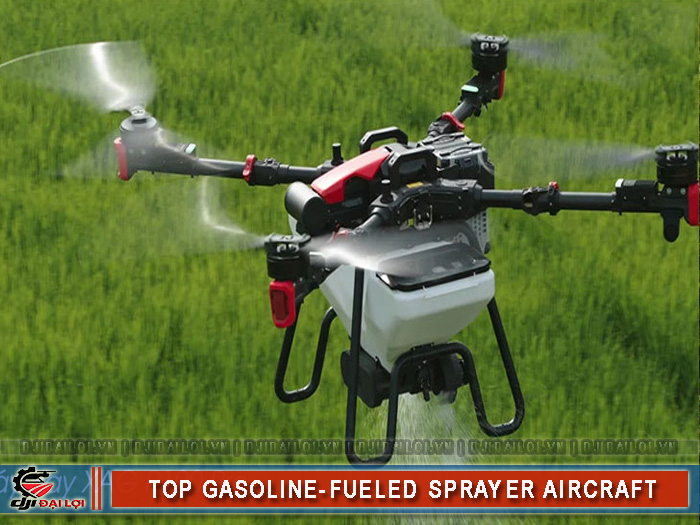
Despite the rise of electric UAVs, gasoline-powered spraying drones continue to play an essential role due to their endurance and reliability. Without depending on battery life, these drones are ideal for large-scale farms that require longer flight times and stable power output. Compared with electric models, gasoline engines deliver 30–40% higher spraying performance and are less affected by power interruptions.
Key advantages include:
For this reason, large-scale farms and agricultural cooperatives often prefer gasoline drones over electric ones.
|
Criteria |
Gasoline Drone |
Electric Drone |
|---|---|---|
|
Average flight time |
45–60 minutes |
20–25 minutes |
|
Payload capacity |
15–60 L |
10–40 L |
|
Spraying rate per hour |
6–12 ha |
4–6 ha |
|
Fuel/electric cost per flight |
30,000–50,000 VND |
70,000–90,000 VND (charging) |
|
Engine maintenance |
Requires periodic oil changes |
Mainly battery replacement |
Thanks to their longer flight duration and stronger power, gasoline crop spraying drones are now the preferred choice for professional spraying services, while DJI electric drones dominate the smart farming segment with higher precision and automation efficiency.
Engine capacity directly impacts spraying performance and fuel consumption. Drones with 3–6 HP engines typically consume 0.5–0.7 L/ha. High-performance models such as Joyance JT16L-404 HB or HongFei HF T60H demonstrate excellent fuel efficiency and strong output.
Drones with 2–5 L tanks can fly for 45–60 minutes, covering 5–10 hectares per trip. Some hybrid gas-electric models extend flight time up to 70 minutes, reducing refueling frequency during operation.
This depends on the centrifugal spraying system, altitude sensors, and GPS guidance. Advanced models like the XAG P100 gasoline drone feature multi-directional radar for precise altitude control and uniform spraying coverage.
Gasoline drones require spark plug and oil maintenance but can reach a lifespan of 3,000–4,000 flight hours. Carbon or aluminum alloy frames provide strong impact resistance, suitable for Vietnam’s rugged field conditions.
The HIRA HLD-18 uses a 2-stroke gasoline engine with an 18L tank, 45-minute flight time, and 6 ha/hour efficiency. It’s easy to start, low-maintenance, and spare parts are readily available - ideal for small to medium farms.
Highly rated for endurance and durability, the Joyance JT16L-404 HB offers a 60-minute flight time and 16L tank capacity, spraying 6–8 ha/hour with only 0.5 L/ha fuel consumption. It runs on #95 gasoline at a 1:40 oil ratio for smooth performance.
An upgraded hybrid gas-electric spraying drone, the XAG P100 combines automatic spraying with precision RTK mapping and radar sensors. With a 40L tank and 12 ha/hour capacity, it’s ideal for professional service providers.
The HongFei HF T60H is a hybrid gasoline-electric model with a 60L tank, 70-minute flight time, and 20 ha/hour spraying capacity. Its heat-resistant composite frame makes it perfect for rice, sugarcane, and coffee cultivation - a top choice for large cooperatives.
Models like the HF T60H and XAG P100 can cover 10–20 hectares per day. With large tanks and powerful engines, they operate effectively on both flat and sloped terrains.
On average, spraying productivity reaches 6–12 ha/hour - 5–7 times faster than manual spraying. Centrifugal precision spraying reduces pesticide use by up to 20%, ensuring consistent pest control results.
Field surveys show that gasoline drones cost only about 25,000 VND/ha to operate - 50–60% cheaper than hiring manual labor. They also minimize chemical exposure and improve worker safety.
Two-stroke engines are lighter and easier to maintain - ideal for small farms. Four-stroke engines run quieter, consume 20% less fuel, and last longer. Most hybrid models now use 4-stroke engines with electric assistance.
|
Maintenance task |
Frequency |
Technical note |
|---|---|---|
|
Change engine oil |
Every 25 flight hours |
Use 2T or 4T oil depending on model |
|
Clean fuel tank and filter |
Every 2 weeks |
Remove dirt and water residue |
|
Inspect spark plug |
Every 50 hours |
Clean or replace if worn |
|
Lubricate propellers and joints |
Every 2 weeks |
Keeps drone operating smoothly |
Use genuine oil when changing. Drain old oil completely before refilling. Clean the spraying system with water after each shift to prevent clogging.
If starting is difficult, check for carbon buildup or excessive spark gap. Clean with a brass brush and tighten properly.
Avoid humid conditions. Empty fuel tanks and store the drone in a dry place. Run the engine idle for 5–10 minutes monthly to preserve engine performance.
Hybrid power systems combining gasoline endurance with electric quietness and eco-efficiency are the future of agricultural UAVs - offering both long flight times and fuel savings.
Small farms should choose mid-capacity gasoline drones that are easy to maintain and have readily available parts. Large cooperatives can invest in hybrid high-capacity models like the HF T60H for higher long-term returns.
In summary, with long flight time, strong performance, and excellent fuel economy, the top 4 gasoline crop spraying drones listed above are ideal for large-scale agriculture. The right investment can cut costs by 40–50% compared with manual spraying - increasing profits and operational efficiency.
Yes. Compact models like the Joyance JT16L-404 HB with 16L tanks are ideal for farms under 10 ha, offering fuel efficiency and high productivity.
Locally made drones are easier to repair and maintain, while imported models like the HongFei HF T60H are better suited for large-scale operations.
After every 25–30 flight hours, change the oil, clean the spark plug, and replace the fuel filter. Regular maintenance keeps the engine efficient and extends its lifespan.
Most agricultural UAVs use A95 gasoline mixed with 2T or 4T oil at a 1:40 or 1:50 ratio depending on the engine type. Correct mixing ensures smooth operation and fuel efficiency.
Purchase from authorized distributors that provide certified UAVs and official technical warranties to ensure product quality and after-sales service.